American Akita: description and content of the breed
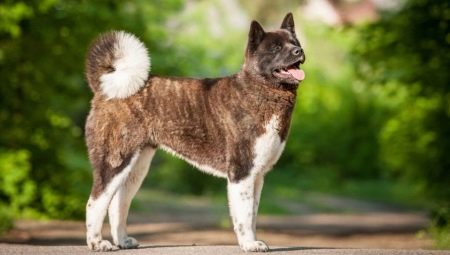
As companion dogs of samurai and shoguns, American Akitas were considered brave and fearless. They often frightened off strangers by their appearance. Dogs were also used for hunting game. They are now excellent companion dogs and are used as watchdogs and harness dogs. To this day, courage and loyalty are integral elements of their character.
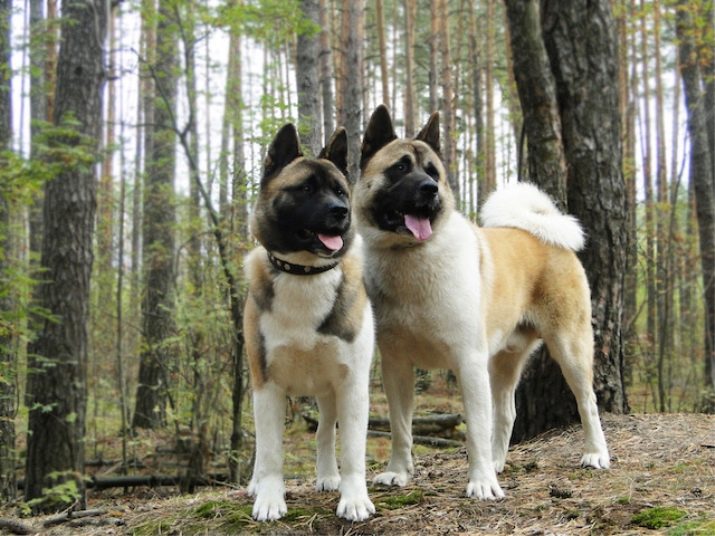
History of origin
American Akitas are one of the oldest breeds in the world. On the rocks were found drawings similar to this rock, which appeared about 5000 years ago.
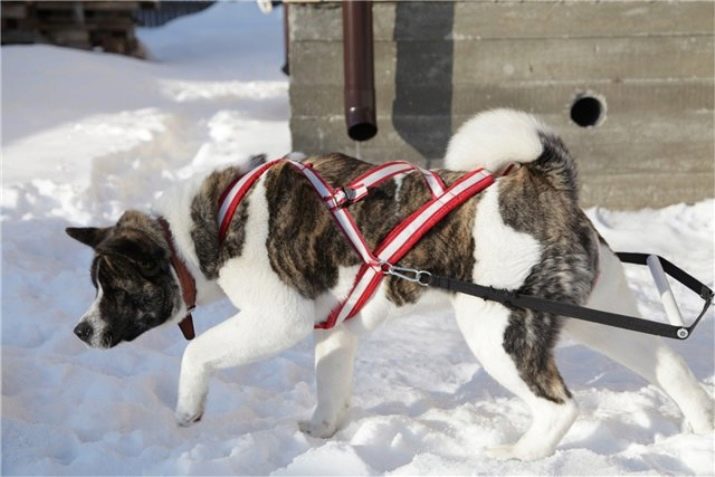
The exact origin and pedigree of the breed remain unknown to this day. There is an assumption that it was founded in the 17th century. In Akita province, in the northern region of Hoshu Island, Japanese aristocrats decided to breed a bold, strong hunting breed.But that individual was smaller than today's Akitas. They were elite dogs. The only owners and breeders of Akitas could only be Japanese shoguns. The way of caring for the dogs was classified. This testifies to the high respect that dogs of this breed enjoyed.

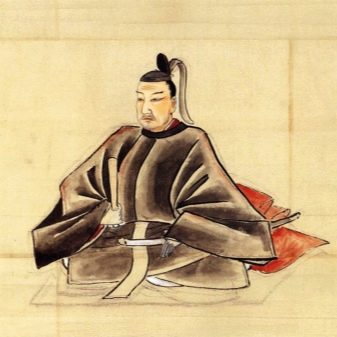
At the end of the 19th century (about 1897), as a result of crossing Akitas and Japanese fighting breeds, an aggressive breed of impressive size was bred. This led to the almost complete disappearance of the purebred Akita. The Mayor of Odate City, Mr. Shigei Izumi, defended the breed's purity and championed its preservation. Public opinion supported the movement to protect the purity of the breed, and already in 1919 a law was passed on the preservation of Akitas. But due to the large number of different types of dogs, it was impossible to maintain the characteristics of a purebred breed.
The results were presented in the works "The Origin of Japanese Dogs" and "The History of Keeping the Japanese Dog Breed" by Hiroshi Saito, as well as at a meeting of the Zoological Society in 1922. In 1927, the Akiho standard was developed.
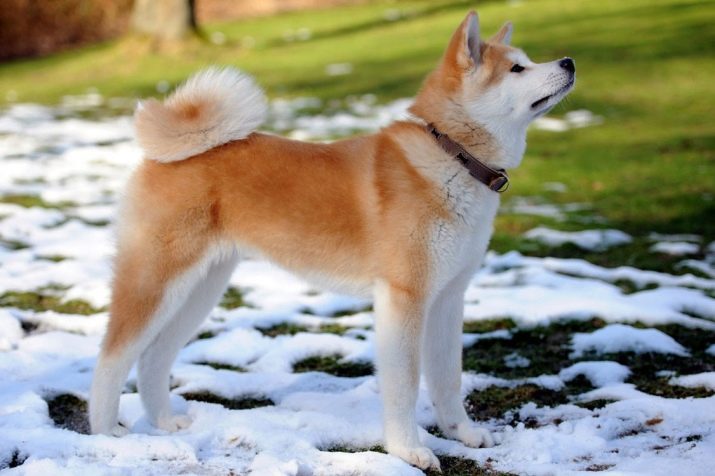
In 1931, the dog population was restored under the leadership of Dr. Tokyo Kaburagi, and in 1931 the name of the Akita breed was changed.
In 1931, the Akita was officially recognized as the "national dog of Japan" and the export of these dogs was prohibited. During the Second World War, the breed almost became extinct. Mainly due to an acute shortage of food - every person feeding a dog was considered a traitor. Keeping such large dogs was too expensive and could not be detrimental to human life or health. Dogs were used for meat and skin. No more than a dozen dogs of this breed survived the war. In the post-war period, dogs reproduced poorly due to diseases and malformations.
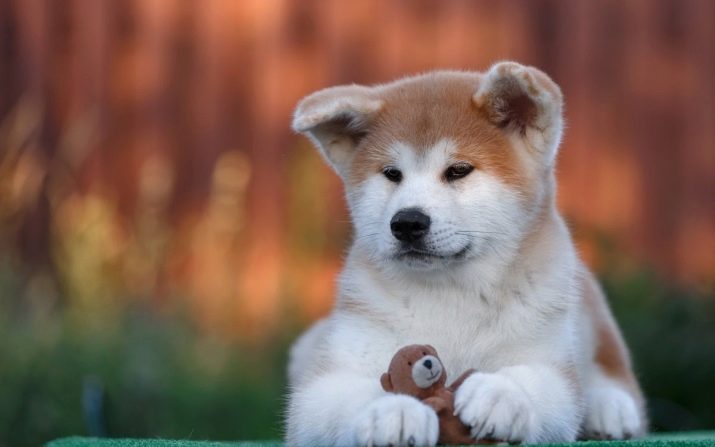
The first dog brought to the United States was presented to Ms. Helen Keller in July 1937 from Mr. Ichiro Ogasawara (later Chairman Akiho).
After the war, the popularity of Akitas in the international arena increased. The American soldiers who returned to the country brought these wonderful animals with them.
At the time, the Kongo-Go dog won the JKC show, and a dog of the same type that won the Akihoco show sparked an increase in interest in the breed, especially from the late 40s to the mid 50s. Dogs of the Kongo-Go line were large, well-built and majestic, however, their appearance was different from that of the Japanese breeders.
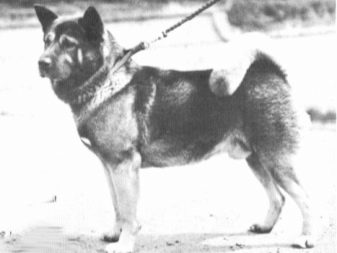
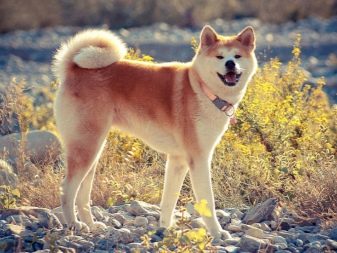
Akita is a symbol of loyalty. These are dogs in love with their owners, loyal to them to the end. An example of this is the story of Hachi-Ko, a dog, thanks to which the world learned that there is a creature (unfortunately, not a man, but a dog), for whom the concept of love, devotion and loyalty is not just empty words, but the meaning of life.
Hachi-Ko, an Akita Inu puppy, was born in 1923. It was owned by a professor at the University of Tokyo, Eisubaro Ueno. When Hachi-Ko grew up a little, he accompanied his master to Shibuya station. He returned there daily at four o'clock in the afternoon to meet his master. Every day a man and a dog, regardless of the weather, parted and greeted each other in the square in front of the station. It seemed that nothing could disturb the harmony that reigned between them.
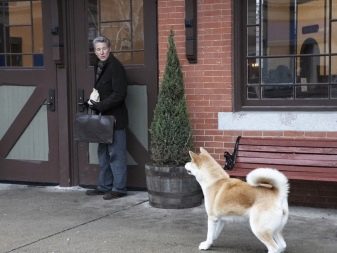
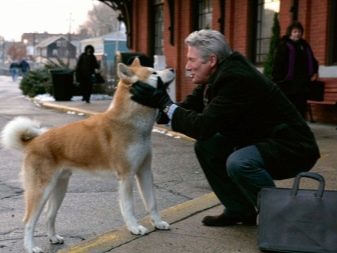
However, in 1925, when the dog was 18 months old, Hachi-Ko, as usual, said goodbye to his master getting on the train, but did not wait for his return by four o'clock. Eisubaro Ueno died at work. Everyone knew about this, but no one could explain this to the dog, which returned to the square every day, looking for its beloved owner at the station door. This lasted 9 years until the death of the dog.
Every day at the same time the dog returned to the place where it had said goodbye to its owner for the last time.
Friendly people took care of her. But no one could replace Eisubaro Ueno's dog. Hachi-Ko became famous thanks to an article that appeared in the press on October 4, 1932, entitled "A touching story of an old dog", and in honor of his devotion, a bronze monument was erected by the Japanese sculptor Teru Ando.
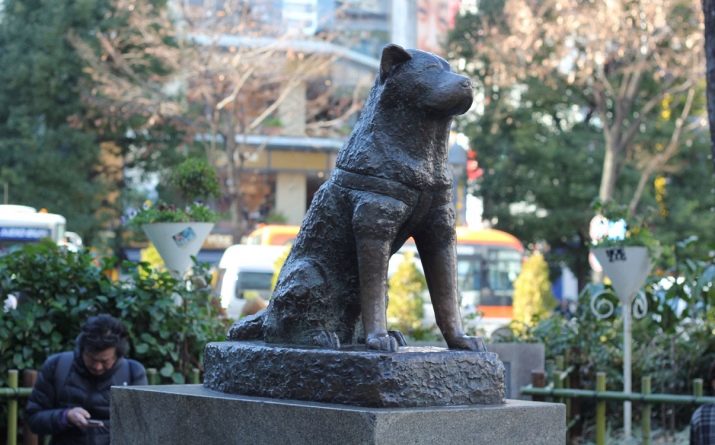
Another example of this unusual devotion to man is the story of 12 Akita dogs, which in 1957 took part in a scientific expedition along the southern route. Due to difficult weather conditions, the Japanese scientists were forced to return from the middle of the route, leaving their equipment and dogs behind.
When the expedition was resumed three years later, researchers found 12 of the 20 dogs remaining in the former camp. They survived the extreme conditions, were healthy and in good health. Emperor Hirohito ordered to erect a monument in their honor - 12 life-size dog silhouettes cast in bronze near the Tokyo Tower.
Japanese literature portrays the Akita as an ancient and indigenous dog with certain beliefs associated with it. Small wooden figurines depicting Akita performed by Japanese sculptors were presented as gifts - symbols of happiness.
It was believed that the Akita statue presented to the baby promised him strength, health and wisdom.

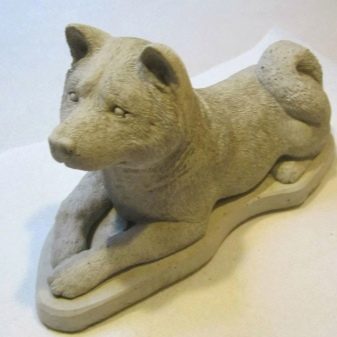
Description of the breed
The American Akita is a dog with a strong constitution and great weight. Its head is characteristic in the form of two equilateral triangles.
There are a lot of varieties of color shades of fur in this breed. There are dogs with red, red, fawn, white colors. As well as various mixed colors and patterns (for example, tiger). Spotted individuals have large, evenly spaced spots on a white background of the head and body. The color of the undercoat may differ from the color of the outer coat, which is especially evident in the long-haired Akita.
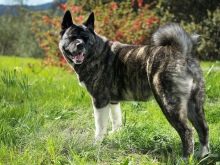
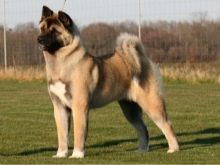

The table below shows the main characteristics of this breed.
American Akita - breed properties (on a 10-point scale):
|
Obedience in training |
3 |
|
Mental capacity |
3 |
|
Molting |
10 |
|
Guardian qualities of a dog |
6 |
|
Agility |
6 |
|
Popularity of the breed |
7 |
|
Dog size |
7 |
|
Attitude towards children |
5 |
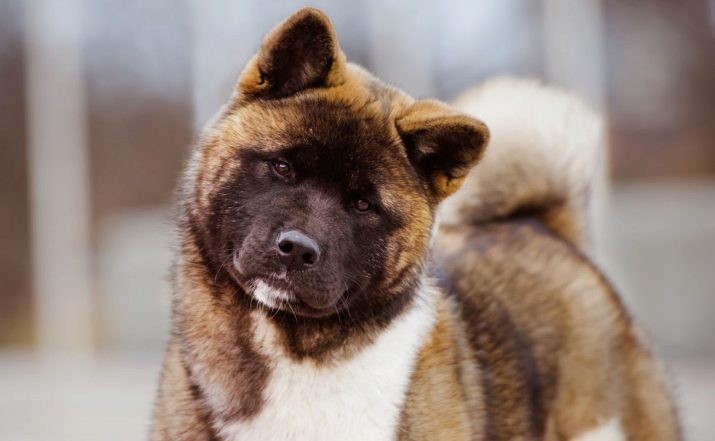
Character and behavior
Large Japanese dogs are suitable for calm and at the same time strong people. Improper upbringing of these dogs can make them shy or aggressive. Mutual understanding can be achieved through friendly, patient and consistent parenting. However, the dog belongs to the dominant individuals, so the pet will try to subjugate the family members.
Despite this, Akitas are very intelligent, they can be trained, for example, in the field of canine sports.
Submission is unfamiliar to them. Only kindness and patience will achieve the intended goal. The American Akita is ideal for finding people trapped in a mountain avalanche.

Besides, you can never be 100% sure that the Akita will obey you, even if the dog is well-bred. In forested areas rich in game, it is better to keep the Akita on a leash, as the hunting instinct is present in the genes of this breed.
The beautiful fur of these dogs consists of two layers (wool and undercoat), it is very easy to care for it. Only in case of hair loss (shedding), daily brushing is necessary twice a year.
The American Akita comes in many different colors and color combinations, including black, white, chocolate, or brindle.

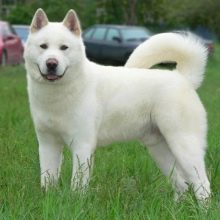
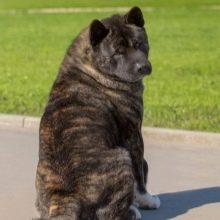
They tend to be stubborn and dislike outsiders. These are good qualities for a watchdog, but an experienced trainer is required if interacting with other animals or people is to be expected. Beginners are wary of this breed. Nevertheless, Akitas are loyal companions who will be attached to their master for life. So if you and your family are up for the challenge, you will have a lifelong friend who won't let you down.
The size of males is about 70 cm, weight is from 38 to 60 kg; females - 63 cm, weight from 30 to 50 kg.
Big Japanese dog - great individualist. Akita is confident, stubborn and bossy. With the right upbringing from an early age, the dog will be a reliable and affectionate friend of the family.As for strangers - Akita is in no hurry to make friends with them, which makes her an ideal watchman. This is a balanced dog, but in battle it is cruel, ruthless and unstoppable.
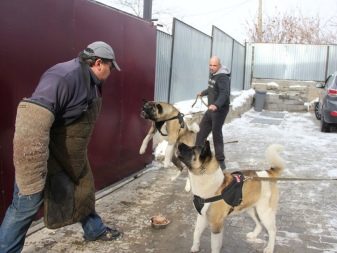
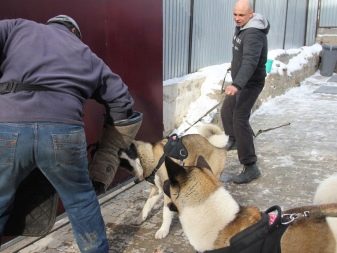
Obedience training should begin as early as puppyhood, as these are dominant dogs. Once they get a superior position, they will try their best to maintain it, which can be very dangerous for anyone who wants to deprive the dog of this position. Because of the above, Akita is not suitable for the elderly, the physically weak, and also overbearing, submissive or nervous.
A typical feature of the breed is the attachment of dogs to their owners, which can be seen by anyone who has chosen a dog of this breed as a companion.
They were originally used as hunting dogs to hunt wild boars, deer and even dangerous black bears. They were prized for their stubbornness and ruthlessness in the struggle, as well as for their hunting passion.
When hunting bears, they usually worked in pairs. At first, the animal circled around the prey, and when the bear climbed on its hind legs, the first dog attacked the side of the animal, while the second gnawed at the throat. The battle took place in complete silence. Dogs often died from the paws of a bear. One source reports that a 400-pound grizzly bear fell on a couple of dogs in Colorado, USA after a 30-minute battle.
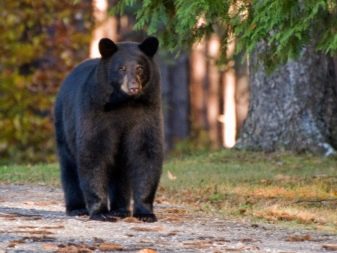
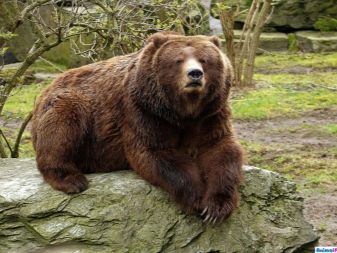
Old sources depict the Akita as a dog that helped fishermen to fish. The dog usually sat next to its owner on a rock, almost a meter above the surface of the water, and watched the behavior of fish (trout and salmon) near the shore. When the fish swam near the shore, the dog, on command, jumped into the water to catch it and bring it to the owner. According to available data, the average fishing efficiency was around 60–70%.
These essentially quiet dogs also worked as watchmen, protecting livestock from wild boars. Over time, as their popularity increased, the Akita, known for her strength and determination, became a popular fighting dog, especially in the Kazuno and Senbok regions. The battles were the subject of numerous bets, and the interest in them was so great that championships were held. Usually fights took place on small podiums surrounded by a net. In each case, the fight ended in the death of one of the dogs. This increased the victor's aggression as the number of defeated opponents increased.
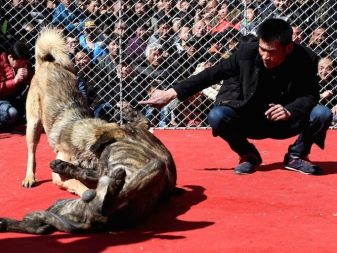
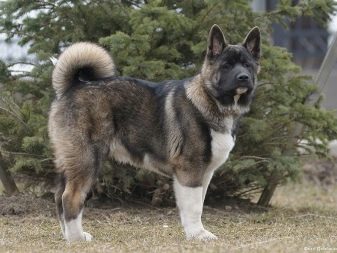
This breed is known unwavering dedication to their owners, and they can be surprisingly sweet and affectionate with family members. Imagine a loving protector who will follow you from room to room, and his whole mission in life is simply to serve you. Akita is a courageous, natural guardian of the family. Stubborn and strong-willed, they will not back down from the test. They usually don't bark unless there is a good reason, but they scream loudly, make funny grunts, groans and mumbles. Some owners say the Akita is muttering to itself and seems to be talking to itself.
Others argue that the Akita has a say on everything from how to load the dishwasher to when children should be put to bed.
While these adorable "speaking" traits are evident in the family, Akita is often on the sidelines and is silent in the presence of strangers. They are naturally wary of strangers, although they will be hospitable enough to the guest as long as their owners are at home.
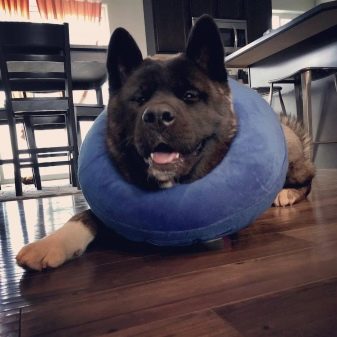
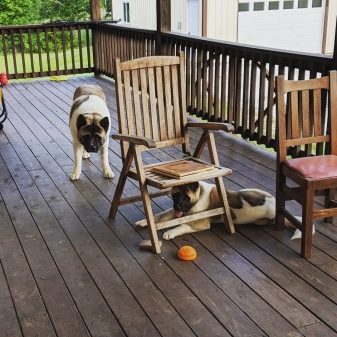
One of the special features of the Akita is its mouth. Akita loves to wear things in his mouth, including your wrist. This is not an act of aggression, but simply a way of communication between Akita and those they love. They can lead you to their leash because they want to go for a walk, for example, or point out any number of other ideas that pop into their smart head. They will gladly bring you a newspaper or your slippers. Akita also appears to be unusual, licking her body like a cat.And this is not their only "feline" trait: like a tiger, they will silently pursue their prey, cuddling low to the ground.
Adults should always monitor interactions between dogs and children, and this is especially important for this breed.... No child can have a more loyal guardian and playmate than an Akita, but mistreating an Akita can become a hindrance and even endanger your child's life. It is imperative to teach children to be respectful and kind in all relationships with dogs. Play between dogs and children should always be supervised, even with well trained animals. However, Akita is suitable for families with older children.
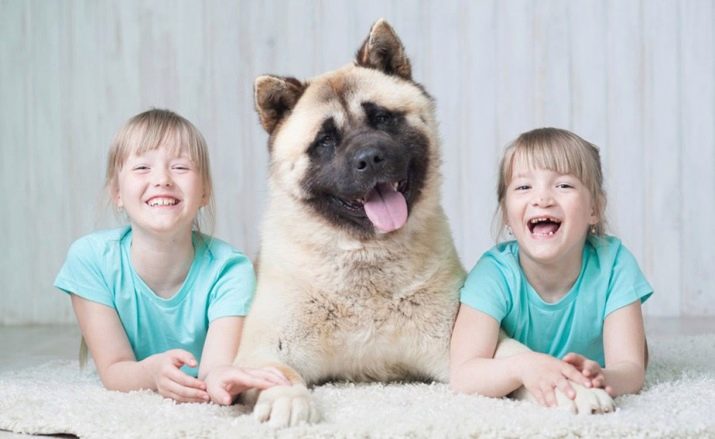
Advantages and disadvantages
Advantages:
- loyal and family-attached dog;
- good watchman;
- active, can go in for sports;
- smart, he learns quickly with the right upbringing;
- the fur does not absorb dirt;
- quiet.


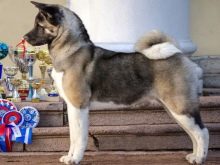
A negative property is that a representative of the Akita breed is:
- stubborn and independent;
- tends to dominate;
- aggressive towards strangers and dogs;
- has a strong hunting instinct (on a walk this can be a disadvantage, but on a hunt it can be an advantage);
- it sheds heavily twice a year.
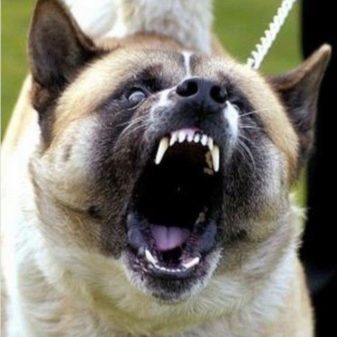

How is it different from the Japanese Akita Inu?
Despite the fact that the Japanese and American Akitas have the same origin, they evolved in different conditions. In the United States, strong and strong Akitas with a calm character are bred. In Japan in the 1960s, in accordance with the fashion that prevailed at the time, slender and small individuals were bred. As a result of the differences in both types of these dogs, it was decided to classify them as:
- akita inu (Japanese Akita), counted by the Kennel Club in Group V;
- large Japanese dogs (American Akitas), included in the II group.
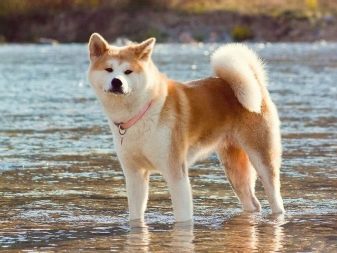
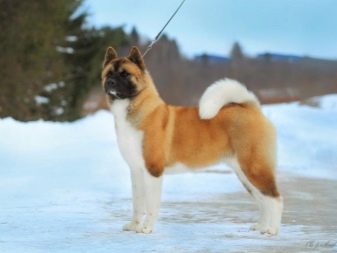
Japanese Akitas are smaller and lighter in body weight than their American counterparts.
Their fox-like heads have significant clear differences from the widened head of the American Akita. The Japanese dog has almond-shaped eyes. American - triangular.
The black mask is very popular on the American Akita, but is not recognized in Japan, where the markings on the muzzle are white. In America, any color on the Akita is allowed; in Japan, only red, white and some brindle are allowed. The difference between the types of these breeds is quite large.
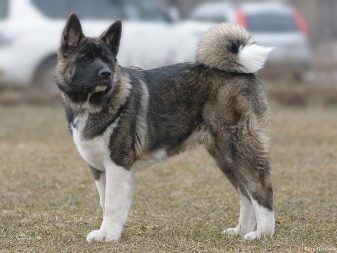
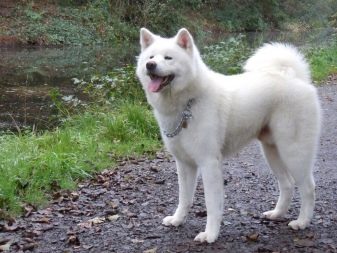
Choosing a puppy
There are a few things to remember when choosing a puppy.
Pedigree
Only the pedigree guarantees that a proud Akita will grow from the little fluffy ball you brought home.
When buying a puppy, you should receive birth certificate confirming that your puppy was born from a carefully planned combination of two purebred Akitas.
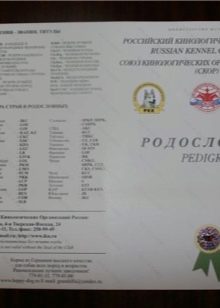

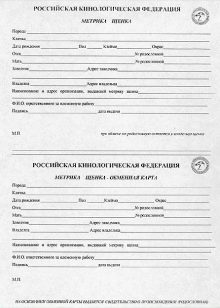
Akita character
It should be remembered that the Akita has a complex character, quite independent. Therefore, you must treat it decisively, but carefully. In Akita training, consistency is important.
When you give a command, do not expect that it will be immediately executed - it is good if he can be bribed with something tasty.
You have to be even more stubborn than your dog.
Akita does not get along with other dogs and does not tolerate their being around. When deciding to purchase an Akita, you must remember that when your puppy grows up, you may be doomed to walk alone with your dog.
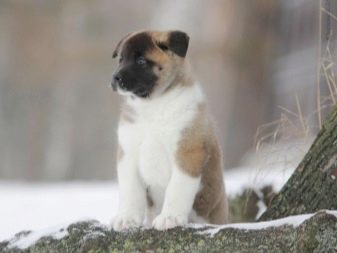
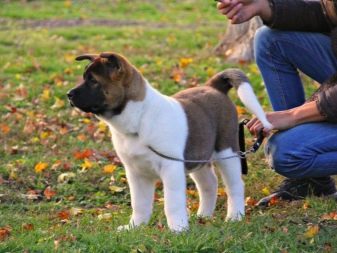
Breeding place
One option is to find your puppy online. There is one more opportunity - dog shows.
Before making the final decision to buy a puppy, it is recommended to personally visit several kennels, to see the conditions in which the dogs live. In the kennel, you will immediately see if the dogs are well groomed, if they eat right, if they have conditions for running and other physical activity.
Breeding carried out in an apartment building or too small nurseries is not recommended.
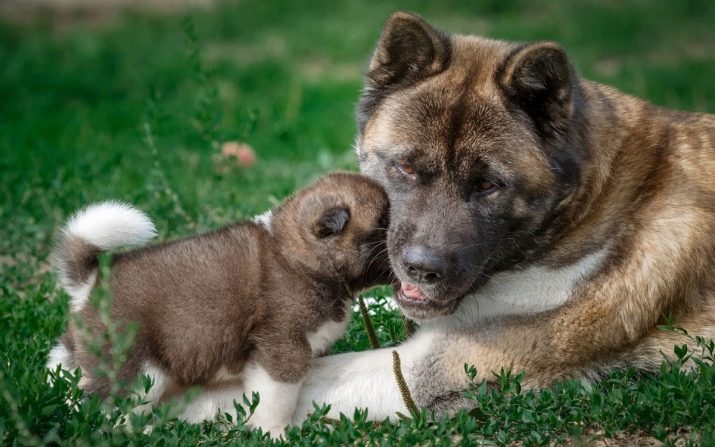
In the first case, it is mockery of animals.Do not trust a breeder who says that dogs live together in perfect harmony. Usually in a small area, dogs are kept in small cages. In the second case, this is normal production for money, which has nothing to do with the idea of breeding purebred dogs.
Only with personal participation can you be sure that the puppy grew up in suitable conditions.
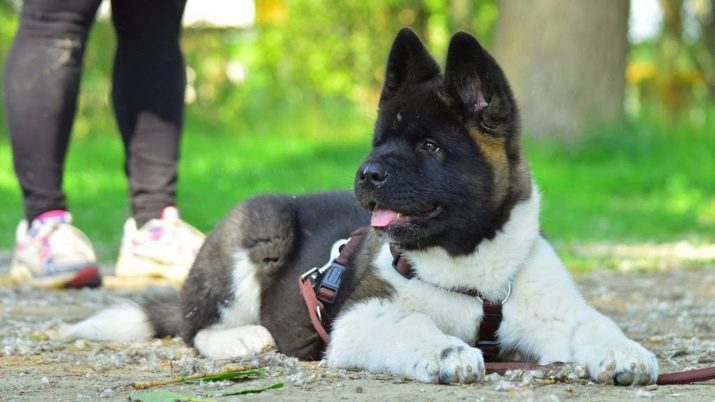
You took the puppy and what's next ...
New house
You have a small, long-awaited Akita. The puppy will surely consume all your free time. Therefore, it is worth taking a vacation so that in a few days the puppy will get used to you and the new conditions.
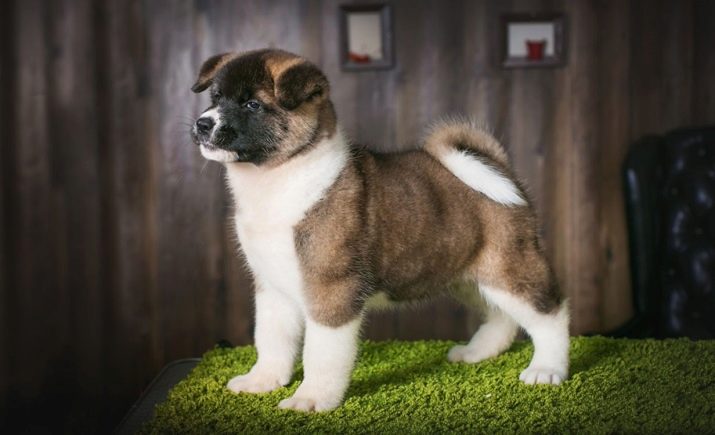
Nutrition
When choosing an Akita, clarify how the puppies ate in the kennel. Nutrition is a very important issue, especially during puppyhood. For at least the first few days, the puppy is usually given the food he ate in the nursery. Puppy diet: raw and boiled meat, white cheese, natural yoghurt, rice, dumplings, vegetables and fruits.
Adult Akita can be fed with dry food. But do not skimp on food, because over time it will affect your pet's health. Various types of food are recommended - dry food, cooked food; sometimes raw meat, veal thigh, lamb, horse meat, beef. Remember that too much protein can cause allergies.
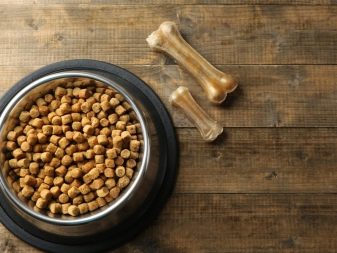
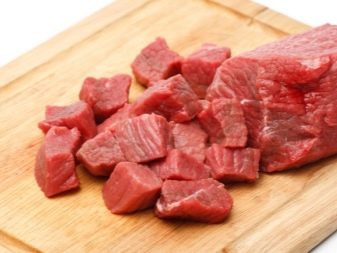
It is necessary to clarify about vaccinations given to a dog when buying a puppy, and in the future, consult a veterinarian.
Conditions of detention and care
Akita molting takes about three weeks, it is very abundant and usually repeats twice a year. During this time, the dog loses mostly soft undercoat that is easy to clean.
The peculiarity of the molt of this breed is that the wool does not fall out evenly over the entire surface, but comes off - like wolves. The dog needs to be brushed daily (usually only once a week), but you must do it carefully because the skin becomes sensitive and more susceptible to irritation.
It also happens that during molting, the dog may even seem sick.
Best for grooming metal comb of medium thickness.
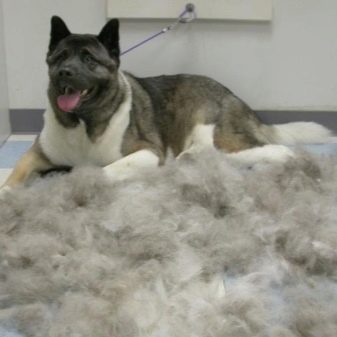
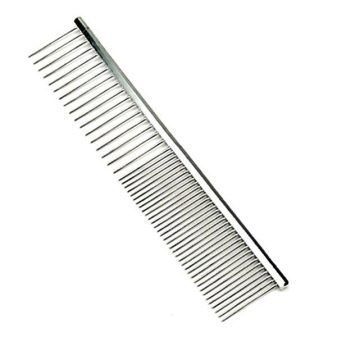
If you want to exhibit your pet in competitions, then keep in mind that a representative of this breed does not need special preparation for the show.
The best toys for puppies of this breed are thick cords, hard balls and natural teethers. You should also train your puppy to the toys belong to the owner, and the dog receives them at a certain time.
This breed needs daily exercise, which is not always convenient to do at home. A half-hour walk a day is enough for an Akita. Brisk walks, jogging (for an adult dog over two years old) and playing in the garden are favorite activities. For the safety of others, walk your dog with a muzzle. A visit to a dog park is probably not a good idea given the Akita's aggressive tendencies towards other dogs.
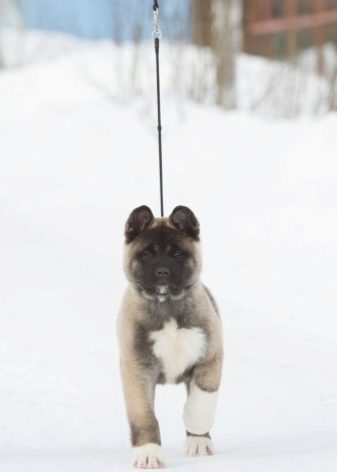
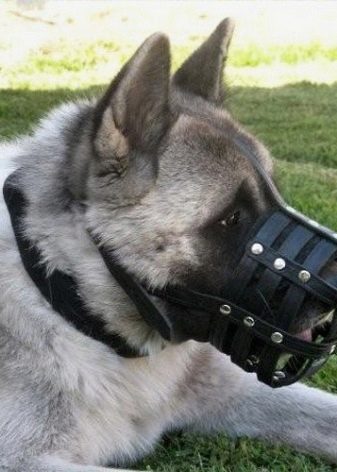
If the Akita is bored, it leads to behavioral problems such as barking, digging, chewing and aggression.
Involve the Akita in family events and do not leave her alone in the apartment for a long time. A well-fenced yard is also important for both the safety of the Akita and the safety of strangers who might mistakenly enter their territory. While they are usually not aggressive with guests if their family is at home, the game conditions change when their owners are not around. Akita is a loyal guardian, and she will protect against anything she considers a threat.
Particular attention should be paid to raising Akita puppies. These dogs grow very quickly between four and seven months of age, making them susceptible to bone disease. Also, do not let your puppy run or play on hard surfaces such as sidewalks. The ideal option is playing on the grass.Avoid forced jumping or jogging on hard surfaces until the dog is at least two years old and his joints are fully formed.
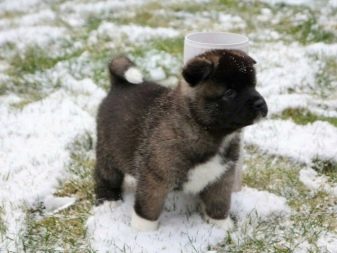
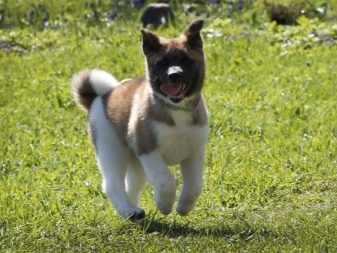
In general, taking care of an Akita is not very difficult. But the Akita is fluffy. Therefore, frequent cleaning will be your lifestyle if you choose this breed. Wool will lie on furniture, clothes, dishes, food. Cleaning the fur weekly will help reduce the amount of hair in the apartment and keep the Akita's coat healthy.
Akita also needs to bathe approximately every three months. Of course, it is possible more often when the pet wallows in a muddy puddle or smells bad.
The nails should be trimmed monthly. Also, once a week, you need to wipe your ears with a special cleaner for the ear canals of dogs. As with all breeds, it is important to start caring for the Akita at an early age.
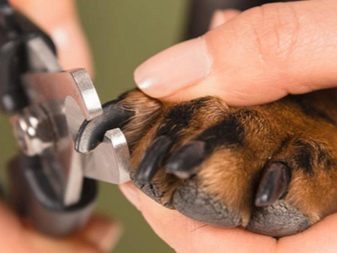
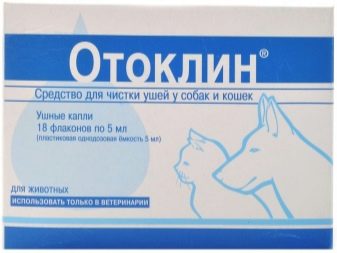
Feeding
Akitas are indiscriminate in their food. The type of food must be adapted to their lifestyle. Dogs that don't move much shouldn't get too nutritious food because they gain weight quickly. In turn, the menu of animals that live outside in winter should be rich in calories.
During moulting, products can be introduced that support hair regeneration and improve the condition of the animal's skin.
There are different opinions on how to feed these animals.
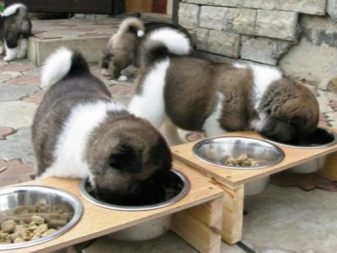
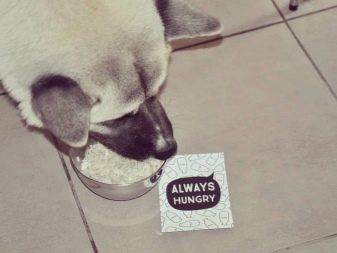
Feeding only dry food
Undoubtedly, this is a very convenient method that does not pose serious problems for a properly balanced diet. It is worth remembering that the feed dosages recommended by the manufacturer are often too high. Therefore, it is better to give a little less so that the dog eats everything without leaving any leftovers in the bowl.
It is most convenient to give high-quality dry food with the addition of glucosamine and chondroitin for large breeds. However, the food should not contain too much protein, because the Akita has food allergies. Lamb or fish products are great for feeding.
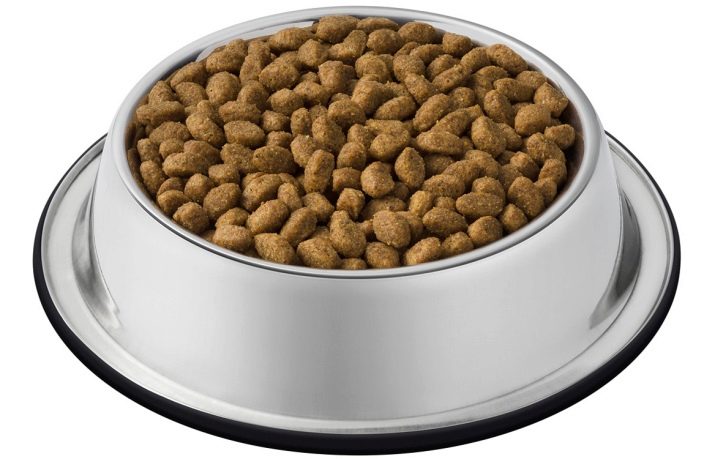
It is best if the food is pre-soaked in warm water. In this way, unwanted gastrointestinal complications can be avoided. If we fill dry food, it is necessary to ensure constant access to fresh water.
For those who choose this way of eating, one important piece of advice can be given - there is no such thing as good food and at the same time cheap. Better to buy more expensive feed or at least in the middle price range.
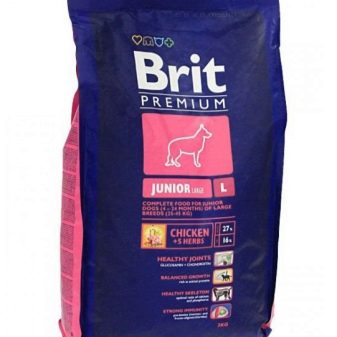
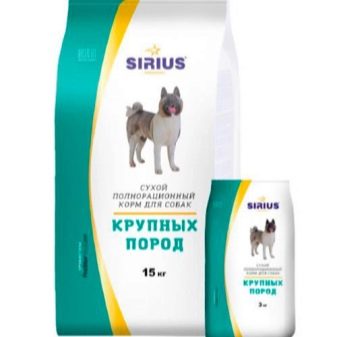
Feeding only natural products
A well-balanced meal should include foods that provide the dog with protein - meat, fish, dairy products.
Beef (including offal), lamb, and poultry are best for dogs. The latter is never served raw due to the risk of contracting salmonellosis. Fish - only seafood, cooked with large bones removed.
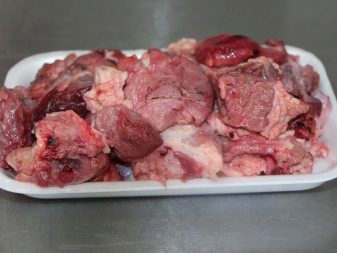
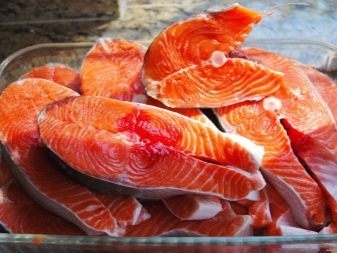
White cheese is especially recommended for puppies and growing dogs. Lean cheese is more desirable.
As far as milk is concerned, it is recommended to give goat's or cow's milk. For both puppies and adult dogs, natural yoghurt is fine and can be added to food. With the natural method, eggs are also served: the yolk or a well-cooked whole egg.
An adult dog is especially suited for carrots, beets, zucchini, pumpkin - finely grated.
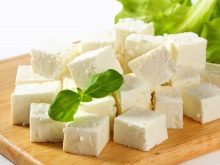
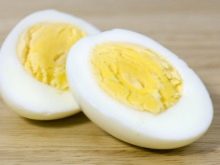
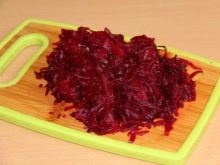
Dogs are also given the fats needed to maintain the proper condition of the skin and coat. Usually, one tablespoon of vegetable oil is sufficient (usually in winter or during moulting). The best oils are corn and flaxseed.
For natural feeding, it is recommended to add vitamins and minerals to the diet.
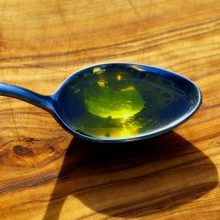
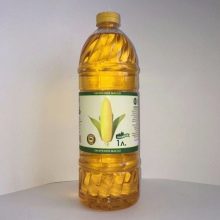

Mixed feeding
This is a method that feed manufacturers do not strongly recommend. But many owners use this type of food, not seeing any signs of harm to dogs in it. They use dry food in combination with liver or fish, as well as a small amount of rice. Puppies receive food and natural food alternately.
Regardless of the feeding method, it is necessary to correctly divide the daily amount of food into smaller portions. Puppies up to 7 months old are fed four times a day. Then, three times a day for up to 1 year. Further, and throughout its life, the dog can have either two or one feedings per day.
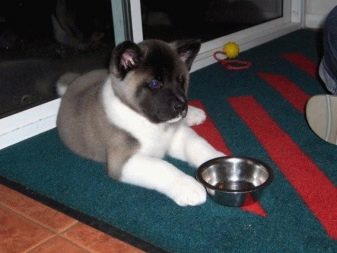
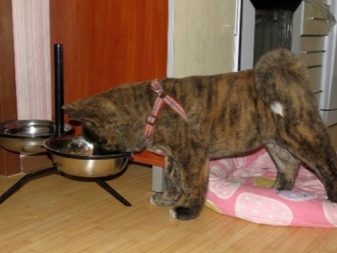
After eating, it is advisable to give your pet an hour of rest for better absorption of nutrients.
Education and training
The American Akita dog is smart, learns quickly, but executes commands only when he understands their meaning. She is independent and can make decisions on her own, which is not always welcomed by the owners. During training, correct motivation, the ability to concentrate the dog's attention and a variety of exercises are important, which should not last too long. Use only positive methods, do not use force. It should also be remembered that Akita usually execute commands much more slowly than other breeds (for example, shepherd dogs).
Puppies require consistency and determination right from the start. Akita has a strong character with a tendency to dominate, so you can't hesitate with education and training. Akita is not a dog for everyone.
The owner must be firm, consistent and take the time to communicate, train and work comfortably with the dog.
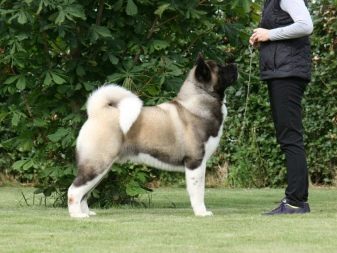
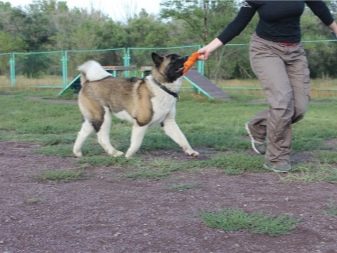
Health and longevity
Although the Akita is naturally hardy, it is sometimes prone to the following ailments.
- Eye diseases: cataracts, progressive retinal atrophy and retinal dysplasia, manifested in partial or complete detachment, resulting in blindness.
- Dysplasia of the hip joints (less often the elbow joints).
- Diseases of the stomach.
- Food allergies.
- Sometimes there are tendencies towards autoimmune diseases, characterized by the destruction of the body's own cells and tissues of the body's immune system. The most common diseases of this type are: pemphigus, sebaceous adenitis (in this disease, the sebaceous glands are destroyed), Vogt-Koyanagi-Harada syndrome, manifested by depigmentation, alopecia and loss of claws, and autoimmune hypothyroidism.
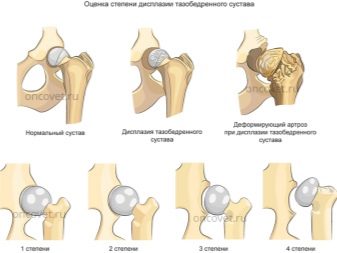
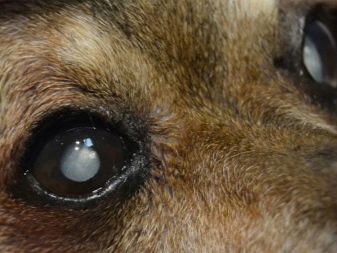
Every few days it is worth checking the eyes and ears and systematically giving the dogs teethers or accustoming them to toothpaste and a toothbrush.
Resistance to weather conditions is very high. Akita easily tolerates large frosts. However, she does not like wind and humidity, as well as excessive heat. Therefore, it should be protected from strong sunlight in summer.
Life expectancy: 10-12 years
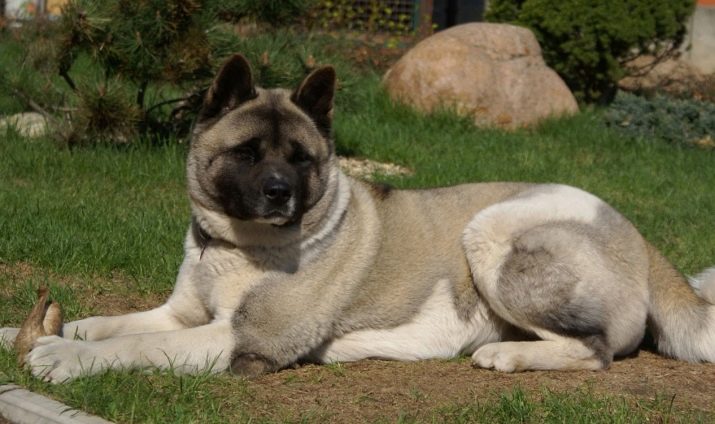
Suitable nicknames
For boys, you can choose:
- Abaris, Abdul, Abiz, Aden, Adonis, Alf, Adoor, Alamo, Amber, Arnold, Alvaro, Iron, Agat, Akari, Aramis, Arden;
- Barney, Bilbo, Brian, Bruce, Bregon, Black, Byron, Benjamin (Ben), Brutus, Boyar;
- Dakar, Danny, Dustin, Dexter, Dandy, Draco, Dingo (Dean), Dollar, Don;
- Maestro, Martin, Max, Mickey (Mick), Merlin, Morgan, Maurice, Misha;
- Parsifal (Parsi), Pedro, Pluto, Poseidon, Pinko;
- Ralph, Ramon, Ram, Ringo, Rubin, Raphael (Raf);
- Hachiko.
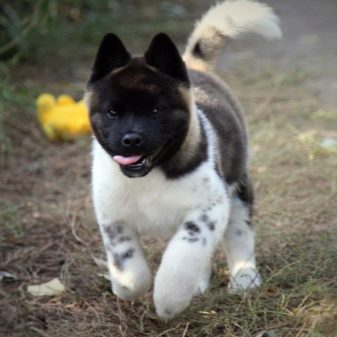
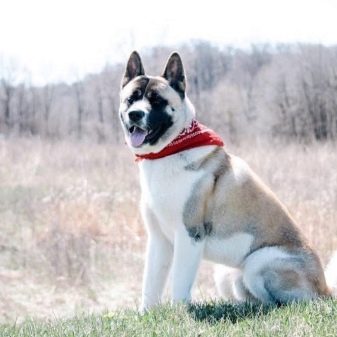
For girls:
- Adelaide, Hayka, Albina, Alma, Allegra, Annabel, Andromeda, Akanava, Ariel, Astra, Arista, Azalea, Alaska, Alexis, Areta, Arina, Assyria, Aurora;
- Olympia, Ohana, Ocher, Opia, Okima;
- Salma, Samira, Sati, Savannah, Sierra, Cynthia, Santa, Suliko;
- Esmeralda, Estima, Etola, Erinia, Evernia.
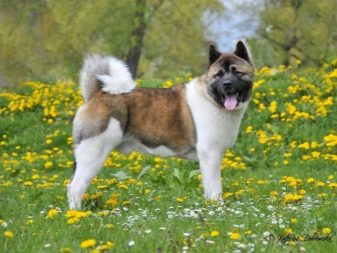
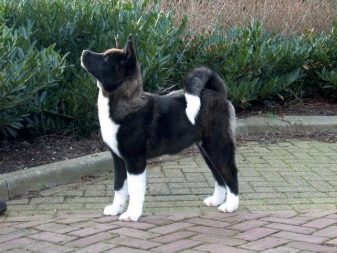
Reviews
According to the owners, the American Akita is characterized as follows.
- Beautiful dogs with thick hair.
- Unfortunately, they are not the best companions for young children. Without proper training, a dog can be dangerous to others.
- These animals are quite complex in nature. The dog is suitable for an owner who is firm and determined and can devote a lot of time to parenting.
- At the same time — with the right upbringing — they are affectionate, loyal, intelligent companions who get along with children (of school age) and can peacefully coexist with other animals.Much depends on the personality of the individual dog, as well as the upbringing of the breeder.
- Dogs of this breed should be treated very individually. If a dog raised by a breeder communicates and plays with young children from birth, then such a pet often loves children of any age for the rest of its life. These conscientious breeders are giving their dogs a fantastic start in life.
- If you are interested in purchasing a dog of this breed, first talk to the breeders. They can tell you not only about the breed in general, but also about the nature of their dogs.
- These dogs shed heavily twice a year, and the hair penetrates all the cracks. Baths help to reduce or get rid of most of the fur, which reduces the need to vacuum and clean your living area.
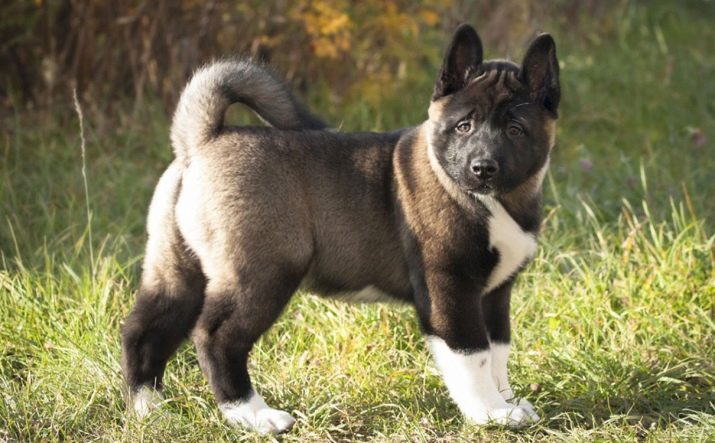
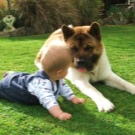
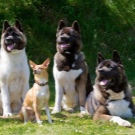
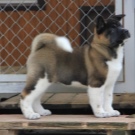
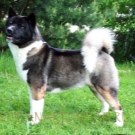

See the following video for the top 5 pluses of the American Akita.




































